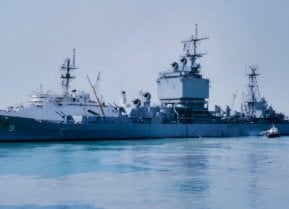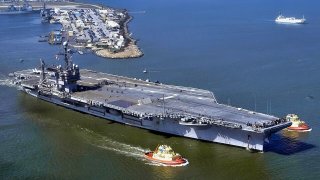What Made Nimitz-Class Aircraft Carrier USS John F. Kennedy One of a Kind
What makes the USS John F. Kennedy so unique is that she was the last conventionally powered aircraft carrier ever commissioned into the Navy. Every carrier since has been nuclear-powered.
Summary: The USS John F. Kennedy (CV-67), named after the esteemed president and naval hero, served as a remarkable vessel in U.S. Navy history. Launched with the blessings of Jacqueline Kennedy Onassis, this conventionally powered carrier stands out for its distinct class, a variant of the Kitty Hawk class, modified during construction. Despite several incidents, including fires and collisions, it played pivotal roles in Cold War tensions and Middle Eastern conflicts. Decommissioned in 2007, efforts are now underway to preserve the Kennedy as a museum, honoring its legacy and the era it represents in naval and American history.
USS John F. Kennedy (CV-67): Preserving a Naval Legacy
Before John F. Kennedy became president, he was a naval officer and a war hero.
The commander of PT-109, Kennedy is celebrated for rescuing men of his crew in the aftermath of a Japanese attack.
Given Kennedy’s vaunted status as a former president and a naval war hero, the U.S. Navy has named several ships after Kennedy. Most recently, the second Ford-class carrier, a $13-billion-dollar, ultra-modern vessel, was named after Kennedy – but this is not the first carrier to bear the name. That distinction belongs to CV-67, the lone ship of the John F. Kennedy class, itself a variant of the Kitty Hawk class.
USS John F. Kennedy Aircraft Carrier: A Standalone Vessel
What makes the Kennedy so unique is that she was the last conventionally powered carrier ever commissioned into the Navy. Every carrier since has been nuclear-powered.
The Kennedy’s keel was laid down in October 1964 at the Newport News Shipbuilding’s Shipway #8. JFK’s wife, Jacqueline Kennedy Onassis, christened the vessel herself, along with daughter Caroline, just two days before what would have been JFK’s 50th birthday. The ship entered service about a year and a half later, in the fall of 1968.
The Kennedy is a modified version of the Kitty Hawk class. The Kennedy was supposed to be the fourth Kitty Hawk, but after receiving so many modifications in construction, the vessel was deemed to be her own, distinct class.
The boat was supposed to be a nuclear-powered carrier, but after construction began, the decision was made to build a conventionally powered carrier. The Kennedy’s island differs from the Kitty Hawk class, with angled funnels to direct smoke and gas away from the flight deck. Most obviously, the Kennedy is 17 feet shorter than the Kitty Hawk vessels, measuring a total of 1,052 feet, with a 192-foot beam and a 36-foot draft.
During the 1970s, the Kennedy was consistently deployed to the Mediterranean, where she helped deal with rising tensions in the Middle East. Eventually, the boat was upgraded to accommodate the F-14 Tomcat and the S-3 Viking – jets better suited to the demands of modern combat.
A Series of Accidents for This Aircraft Carrier
1975 was a notable year for the Kennedy. In June, eight separate fires broke out while the boat was docked in Norfolk, Virginia. Arson was suspected. In November, the Kennedy collided with the USS Belknap, severely damaging that cruiser. Fires erupted on both ships. The Belknap’s superstructure was mostly destroyed, and seven crew members were killed. Aboard the Kennedy, one crewman was killed.
One year later, the Kennedy suffered another collision. On Sept. 14, 1976, the Kennedy was conducting a nighttime underway replenishment north of Scotland when the USS Bordelon destroyer lost control and collided with the Kennedy. The collision caused so much damage to the Bordelon that she was retired.
Oddly enough, the collision with the Bordelon was the second notable event of Sept. 14. Earlier in the day, a faulty catapult caused an F-14 Tomcat to fall off the deck, into international waters, with an AIM-54 Phoenix aboard. The crew members ejected and survived. The U.S. and the USSR both raced to recover the aircraft and the AIM-54 – underscoring the near-constant tension of the Cold War. The U.S. found the wreckage first, preventing the Soviets from obtaining valuable American technology that could have been reverse-engineered.
In October 1983, the Kennedy was deployed to Beirut, Lebanon, after a bombing killed 241 American military personnel. In December, after two F-14s were fired upon, aircraft from the Kennedy were launched in a retaliatory raid on Beirut. One of the Kennedy’s aircraft, an A-6E Intruder, was shot down. The pilot was killed after ejecting, and the back-seater was taken prisoner for 30 days – Jesse Jackson helped facilitate his release.
Remarkably, the Kennedy was not decommissioned until 2007. Before being stricken from the Navy register, the Kennedy made a farewell tour, with stops along the East Coast including the Kennedy’s home port of Boston. Various groups are posturing to convert the Kennedy into a museum piece.
About the Author: Harrison Kass
Harrison Kass is a defense and national security writer with over 1,000 total pieces on issues involving global affairs. An attorney, pilot, guitarist, and minor pro hockey player, Harrison joined the US Air Force as a Pilot Trainee but was medically discharged. Harrison holds a BA from Lake Forest College, a JD from the University of Oregon, and an MA from New York University. Harrison listens to Dokken.


